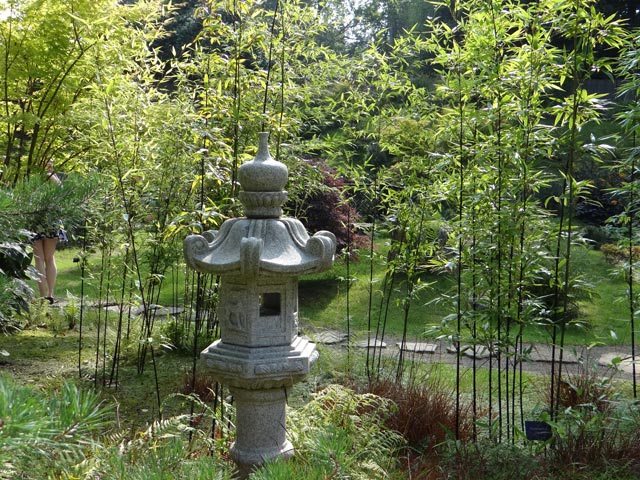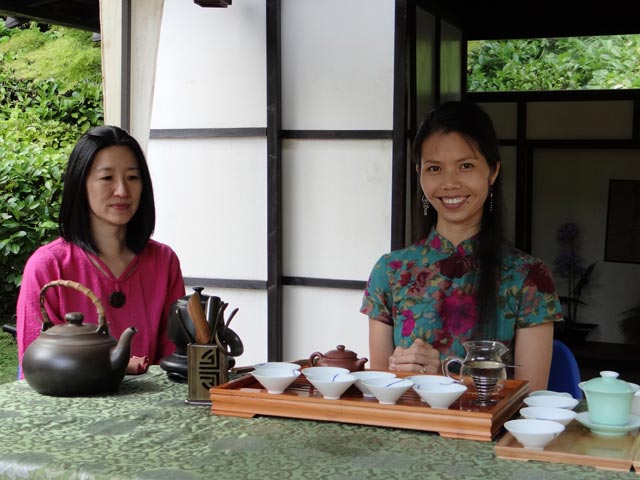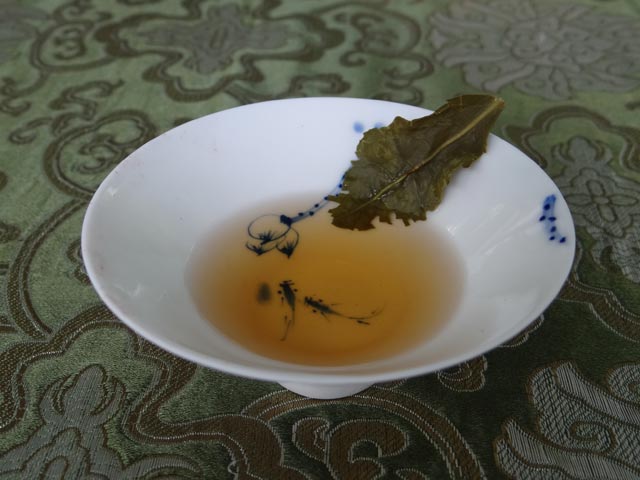Timeless or time consuming? A lasting attraction or a ritual belonging to the past? While keeping an open mind, I had mixed feelings booking a place at a Chinese tea ceremony recently. A self-confessed tea addict, I wondered: will I learn something to take my habit to a new level?
The venue couldn’t have been more fitting. In the contemplative atmosphere of the Oriental Gardens of Kingston Lacy in Dorset, tea expert, Cai Wan Ling, set up accessories for a ceremony which, in more or less the same format, has been conducted since some two thousand years ago. It is hard to believe that in the age of the tea bag, companies in the Far East still have tea rooms where customers are invited to relax and participate in a ritual which is deemed to facilitate business.

While ancient-style ‘tea music’ was played in the background, Ms Ling, like a high priestess laid out the tea table (a wooden double deck tray) with the instruments of the ceremony: small bowl-like tea cups, a clay teapot, a glass jug and wooden utensils for measuring the tea and administering it to the participants.

The tea was spooned into the warmed up clay pot. It rested there for a short while. ‘Waking up’ the tea is essential for extracting its full aroma and flavour. The first brew was brief (the tea was probably still waking up!) and she used it only to warm up the cups and poured it out onto the tray. The second infusion was the ‘proper’ one, and after it brewed for a few minutes in the clay tea pot, she poured it first to the transparent glass jug to check whether it reached the desired colour and intensity.
The first tea we tasted was the semi-fermented Oolong variety which is widely cultivated in Southern China. It has the delicate fragrance of green tea and the sweetness of black tea. Oolong tea can be infused up to eight times, although the third or fourth infusions are considered the best.

The same procedure was applied to two other types of tea from the Wan Ling Tea House collection (www.wanlingteahouse.com) which we sampled. Tea can be purchased in larger quantities (as long as it’s stored in a cool and dry place – she advised), as its taste improves with time, like wine.
People around the world drink five or six basic types of tea – green, Oolong (semi-fermented), white, yellow and black tea, flavored and scented with a variety of oils and plants. Their taste, colour and different properties are due to the ways it is processed and fermented. The more the tea leaf is cut and torn, its colour darkens as the cells of the plant are exposed, and the process of oxidation begins.
Green tea has recently become very popular in the West because of its antioxidant properties. Yet, it should be remembered that the optimum water temperature to prepare green tea is between 70 and 90 degrees. Too hot water will spoil the tea, turning it quickly dark yellow and making it taste bitter.
Jasmine tea, popular in Chinese restaurants, is made by scenting tea leaves with fresh flower buds. It should be brewed in a covered porcelain cup – to retain its aroma.
The tea bush belongs to the camellia family, and it can grow up to 15 meters but at the plantations it is kept to a height of only 1.2 meters and harvested once every few days to ensure that only the most tender leaves are plucked. Cai Wan Ling explained that the optimum time for picking tea is between 9am and lunchtime – as soon as the dew dries out and before the leaves harden. The green tea produced in China is still manufactured using by the same techniques that were employed a thousand years ago. Most of the sorting and grading of the leaves is still done by hand.
In my journalistic capacity I have been invited to some of the best known London temples of afternoon tea, such as the Ritz, Savoy, Claridges and Liberty. Their tea and what came with it, delighted all my senses. Yet the tea ceremony in the gardens of Kingston Lacy had a special quality. It was perhaps the magic of sharing – the stories of tea, tea making and growing, and our own tea experiences, while travelling and at home. It occurred to me that the appeal of a tea ritual is that it brings people together, makes them stop, relax and reflect. After all the ancient name for tea was Tai which meant peace.
While the tea growing heritage comes from the Far East, Britain is known throughout the world as the tea-drinking nation. However it was Russia that first imported tea to the West. Tea compressed into bricks was carried on camels across the Gobi desert – a journey that lasted up to three years. The pleasure of tea drinking was introduced to Britain by the Portuguese princess Catherine of Braganza when she married Charles II. Today, the British drink nearly 11 million gallons of tea every day, with a quarter of us drinking five or more cups a day. For many Brits tea is a first aid remedy for any personal crisis. And, no one can deny that a good cup of tea makes one feel better.
So… now put the kettle on and reach for the tea pot. A mug alone – just won’t do. Warm the pot with boiling water and spoon your favourite tea in (if you’re doing it for the first time, a tea bag will have to suffice). Let it rest for a minute in the warm pot and let the leaves (or what’s left of them in the bag) wake up. Then pour the water and let the tea brew for at least three minutes. Take your favourite cup/mug (38% of us always use the same cup) and remind yourself why you got it/why it was given to you. Pour yourself a cuppa – topping it with milk if you like. Then inhale the aroma and think how lucky you are to be able to enjoy the drink that took a couple thousands years to perfect…
